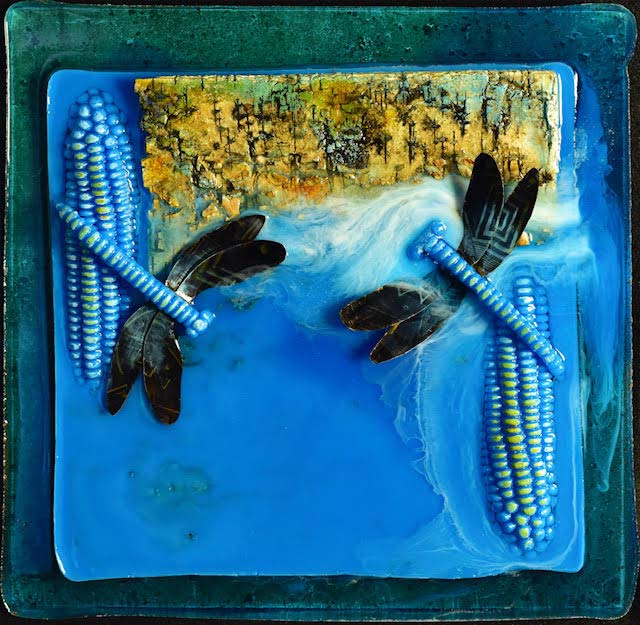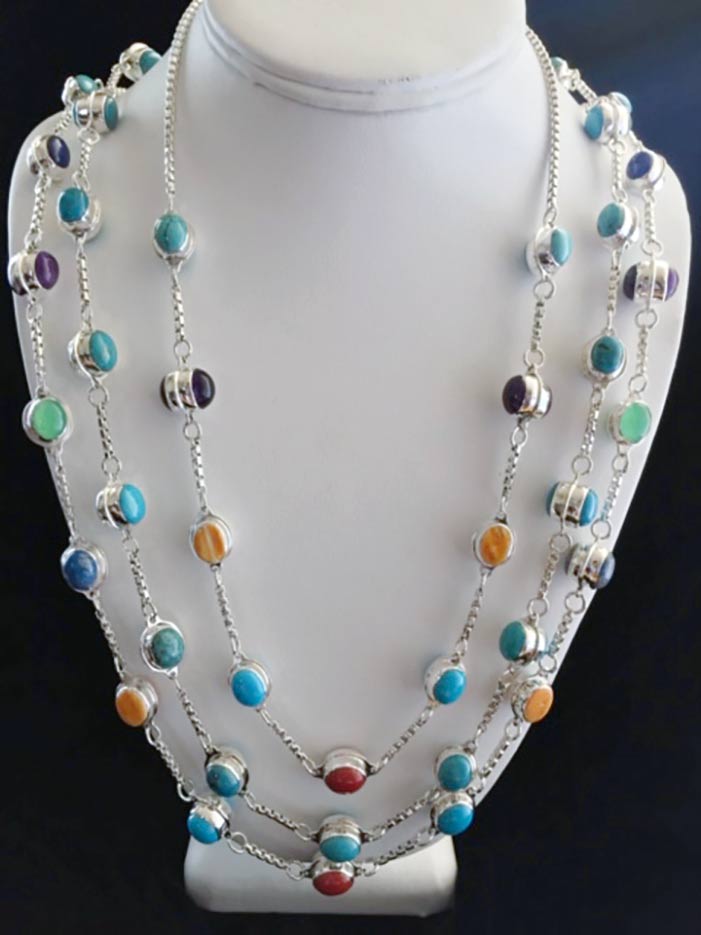
Indian Market re-envisioned during pandemic

Submitted
“Dancing in Water,” a mixed media creation by Dine’ artist Michael Billie made with resin and encaustic on a floating panel.
By Colleen Keane
Special to the Times
ALBUQUERQUE
Diné artists Tonya June Rafael, Michael Billie and Wyatt Lee-Anderson are busy building inventory for this year’s Santa Fe Indian Market. Yes! Indian Market is back on – virtually. The online opening day is Aug. 1, according to Amanda Crocker, communications director for the Southwestern Association for Indian Arts.
The usual market was postponed until 2021 due to the coronavirus pandemic. “It was devastating,” Crocker said.

Courtesy photo | Wyatt Lee-Anderson
A double-sided silver-link jellybean necklace adorned with turquoise, lapis, coral and spiny oyster shell by Diné silversmith Wyatt Lee-Anderson.
For the past several years, she’s seen the market flourish with both traditional and contemporary art and larger crowds from around the world. “A lot of artists depend on the (Santa Fe) market to make ends meet for the year,” said Billie.
Rafael, Billie and Lee-Anderson, all juried-in, are among 350 Diné artists invited to participate in the virtual market. “Right now, I’m sitting in my studio with stones of every color in front of me – turquoise, spiny oyster, coral, lapis, amethyst and topaz,” said Rafael, who creates dazzling one-of-a-kind rings, earrings, necklaces and purses. “I like to make my jewelry look fun.”
“Everything is working out,” said silversmith Lee-Anderson, who was a Santa Fe artist-in-residence before the coronavirus tore apart the art world, devastating livelihoods. “I got all my tools back to the shop (at my home),” he said.
“I’ve been hunkered down making bola ties, pins, and silver link chain bracelets and necklaces. He said adding that he’s known for his colorful “jellybean” necklaces. “They’re double-sided silver with turquoise, lapis, coral, and spiny oyster shell,” he said.
Lee-Anderson shares the home studio with his father, renowned jeweler Allison Lee, and his equally talented twin brothers, Trent and Kyle. “We are a fourth generation Navajo silversmiths from Manuelito (on his mother’s side) and Mexican Springs (from his father’s side),” Lee-Anderson said.
Billie, a mixed media artist, has been showing at Indian Market for many years. At his studio in Farmington, Billie creates contemporary works of art using encaustic and resin.
In “Dancing in Water” he lays the foundation with red clay from the Chuska Mountains. “Something from the rez,” he explains in a YouTube demo. To finish the piece, he delicately lays miniature stalks of sacred corn and dragonflies made out of corn on the surface. They appear to float on top of a turquoise bed of water.
“I like to use elements from Native culture,” he said. “Corn is such a big representation of Native American culture. “It feels fitting to use the color of the sky and ocean to honor Father Sky and Mother Earth,” he added. Sacred bundles, blessings and wedding baskets emerge in his other works.
Moving the market online was the brainchild of SWAIA and its partner, the Clark Hulings Fund, a Santa Fe organization dedicated to supporting artists. “The Clark Hulings Fund has experience in e-commerce, business training for artists and capacity building,” said Crocker. “We put our heads together,” said Elizabeth Hulings, the Clark Hulings Fund executive director.
Hulings founded the organization to honor her father, Clark Hulings, a celebrated American realist painter. “We’re really excited about (the partnership),” she said. “The goal is to help today’s artists succeed as he did and not be afraid to engage in the business side of their practice.”
The virtual market extends the usual weekend Santa Fe street market to one year, giving each artist the opportunity to produce an e-commerce webpage on SWAIA’s website where they’ll be able to showcase and sell their art. They can also link the page to their own websites.
Billie said he hopes all virtual artists will take advantage of the e-commerce opportunity. “I hope it moves Native artists to start thinking about putting more of their work online to get a broader (international) market,” he suggested. Through the partnership, virtual artists will also be able to take business classes at CHF’s digital campus.
“The (courses in sales, promotions and marketing) will really help them take a look at their businesses and take a step forward,” said Hulings. “We have around 85 courses.”
Lee-Anderson said, “For me it will definitely help out. Being an artist you have to know how to promote yourself. It’s actually like having another job other than silversmithing.” The courses are free as part of the virtual booth fee of $200, down from the typical $700 street booth fee. “For $200, artists will get a virtual booth, ability to sell, distance education and support for the entire year, instead of one weekend!” exclaimed Hulings.
To kick off the online market at swaia.org, virtual tours of booths, artist demos and talks, cinema showcases and panel discussions will be featured throughout the month of August.
Crocker added that best of show will also go on during the year-long market. “We want to keep drawing people back to the site to support artists,” she said. Overall, around 1,000 artists, both those juried in and on a waiting list, have received invitations. “I’m happy they’re giving opportunities to all the artists,” said Rafael. “It’s a good way to help (during these uncertain times).”
Santa Fe Indian Market has taken place since the 1920s. The streets around Old Town have swelled with more than 100,000 art enthusiasts. “This is a good step forward,” said Lee-Anderson. “Who knows how many more visitors the virtual market will attract on the internet?”











 Highway 264,
Highway 264, I-40, WB @ Winslow
I-40, WB @ Winslow